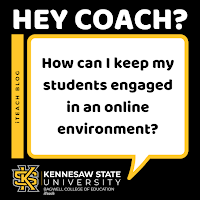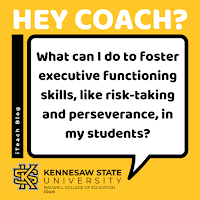Win or Lose with BreakoutEDU
The King's Cup has been stolen and it's up to you to identify the culprit and find the trophy. Well, it's not actually up to you and nothing has actually been stolen. This was the scenario for an activity called BreakoutEDU.
BreakoutEDU capitalizes on the popularity of escape rooms and combines it with content standards from K-12 courses. Students must use communication and collaboration skills in order successfully work together to solve a series of puzzles while at the same time competing against the clock.
Teach to One Math Teachers at Bear Creek Middle School crafted this caper with their KSU iTeach coach Kali Alford. The team was looking for an activity to help keep their students engaged following testing. They incorporated common math concepts from 6th-8th grade with puzzles that would eventually reveal the identity of the culprit and location of the missing artifact and thus the Mystery of the King's Cup was born.
 Aside from setup and a few cues here and there the teacher plays a minor role in the activity. "What's the formula for slope," remarked one student. "I need some help I can't figure out this math problem," declared another. Without any prompts from their teacher, the students were collaborating and communicating in ways that are rarely afforded in the traditional classroom.
Aside from setup and a few cues here and there the teacher plays a minor role in the activity. "What's the formula for slope," remarked one student. "I need some help I can't figure out this math problem," declared another. Without any prompts from their teacher, the students were collaborating and communicating in ways that are rarely afforded in the traditional classroom.
BreakoutEDU capitalizes on the popularity of escape rooms and combines it with content standards from K-12 courses. Students must use communication and collaboration skills in order successfully work together to solve a series of puzzles while at the same time competing against the clock.
Teach to One Math Teachers at Bear Creek Middle School crafted this caper with their KSU iTeach coach Kali Alford. The team was looking for an activity to help keep their students engaged following testing. They incorporated common math concepts from 6th-8th grade with puzzles that would eventually reveal the identity of the culprit and location of the missing artifact and thus the Mystery of the King's Cup was born.
 Aside from setup and a few cues here and there the teacher plays a minor role in the activity. "What's the formula for slope," remarked one student. "I need some help I can't figure out this math problem," declared another. Without any prompts from their teacher, the students were collaborating and communicating in ways that are rarely afforded in the traditional classroom.
Aside from setup and a few cues here and there the teacher plays a minor role in the activity. "What's the formula for slope," remarked one student. "I need some help I can't figure out this math problem," declared another. Without any prompts from their teacher, the students were collaborating and communicating in ways that are rarely afforded in the traditional classroom.
Many of the puzzles were difficult and the countdown timer added yet another layer pressure on to the would-be detectives' investigation. Unfortunately for our gum-shoes, there was not a great rate of success with solving the mystery. Of the 9 student groups (and 3 adult groups) that attempted to solve the Mystery of the King's Cup, only one 6th grade group of detectives could solve the case. Despite this there was a great deal of success in this activity for the students. The students were able to collaborate and support one another. Many of them were able to work on math problems and gain a better understanding of the content as a result. Also most students walked away from the activity having been able to test their academic metals in near real world conditions.
The teachers who crafted this activity could have made the puzzles easier, made the countdown timer longer, and given more hints. However, what they created as a result of not doing those things would've been lost. Solving the mystery was merely the medium and the challenges were formative assessments for the teachers to observe. The students will remember participating in this activity because it was fun, but the teachers know that the real value resided in the students' autonomous learning and demonstration of mastery.
--
Kali Alford
Instructional Technology Specialist
Kennesaw State University iTeach



Comments
Post a Comment